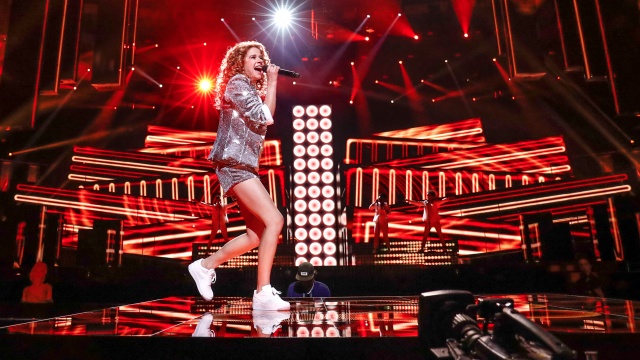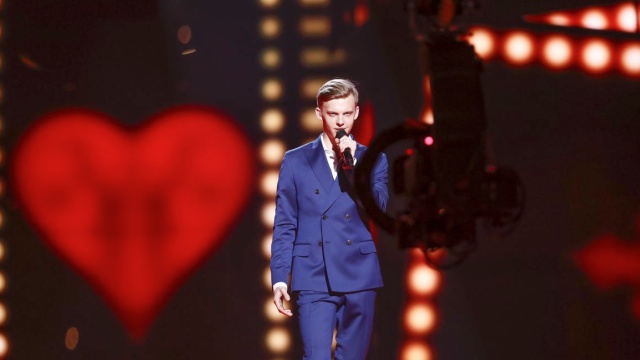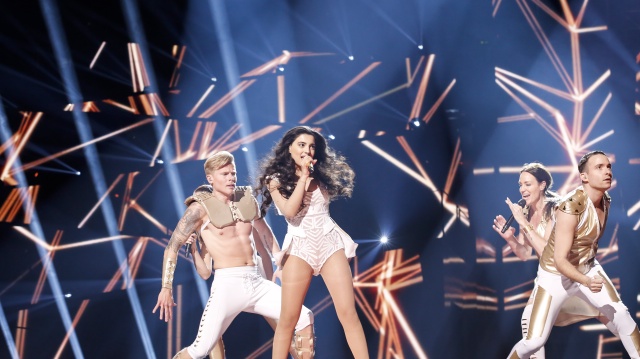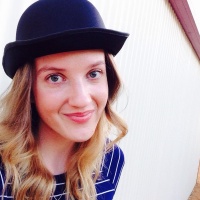Over the past six decades, the stage’s design has become crucial to the percieved success of each Contest — so much so that the expression ‘don’t judge a Eurovision Song Contest by its stage‘ (which I just made up) is now null and void. In addition, the first glimpse of each year’s stage has become more and more hotly anticipated. With each subsequent year, upping the ante stage-wise has almost become a contest in itself. That’s unsurprising when you consider how the stage is key to a host broadcaster making their Eurovision stand out.
Athens’ disco amphitheatre, Moscow’s gargantuan stretch of LED-screen goodness, Copenhagen’s humongous Rubik’s cube homage… so many stages in recent years have reached iconic status. And the 2016 edition of the Contest is set to play a larger part in Eurovision performances than ever before. It’s not only an icon, but a character in the Contest’s ensemble cast of songs, singers and six-foot dandelions.
It’s a game-player, and a game-changer.
The Star Of SVT’s Show
What sets this stage apart? That will be obvious if you read the stage spiel released by SVT, or if you’ve seen the object in question in action this week. But to reiterate, setting this stage apart from those before it — specifically that from Malmö 2013, the Swedish stage still fresh in our minds — was the name of SVT’s game. Designers Frida Arvidsson and Viktor Brattström, who were also responsible for the 2013 stage, made that clear before construction began.
The pair also aimed to devise a stage concept that would make performances limitless, in terms of how distinctive they could be. How does one achieve that? By bringing the stage quite literally to life, of course — allowing the artists to move in it as well as on it and around it. There are multiple rear LED panels present on the Globen stage that can be arranged in a variety of ways — a layered look that creates depth, or a flatter fashion for a more open, spacious feel, for instance. In addition, there is the geometric frame of the stage, the flexibility of which extends in all directions.

Belgium takes to the stage (Image: Andres Putting / EBU)
Consequently, this stage is more noticeable in the grand scheme of things, but for all the right reasons. The Malmö stage may have more closely resembled origami, but the Stockholm stage functions like it. As such, we should be prepared for SVT to transform it into a twenty-foot-high paper crane for Petra and Måns to sit astride at some point.
A Stage for Eurovision The Live Show, Not The TV Show
Since Monday morning, those of us with magical lanyards have been plonked in the Press Centre viewing this year’s rehearsals. From this perspective, the extent of what Stockholm’s stage offers each performance hasn’t been completely clear. The stage looks stunning, but it’s mainly the camera work that has been differentiating and “sizing” the performances — at least from where I’m sitting.
On Friday, though, when I swapped my Press Centre seat for a Globen one, the power of the stage to lend each performance a different look seemed to reach full potential. The contrasts between Estonia and Azerbaijan’s performances, for example, weren’t just down to differing colour schemes or sets of camera shots and angles. That required a live attendance to truly hammer it home.

Estonian Stare Of Death (Image: EBU)
The stage itself stepped up to create contrasting atmospheres — in Estonia’s case, the sophisticated and intimate kind; in Azerbaijan’s, the flashy “music video” kind. Orientation was determined here too: the former was framed closely by the segments of the stage, making Jüri Pootsmann the subject of a portrait; the latter widened out, resulting in a landscape effect.

Samra’s Miracle (image: Andres Putting, Thomas Hanses, EBU)
The positioning of the lights on this stage has a similar ability to shrink or add space to a performance, building on the way Sanna Nielsen’s 2014 cone of lights gave ‘Undo‘ a sense of closeness. Acts can opt for a structured cage of light, which proves symbolic in Serbia’s performance; or loosen things up with a soft, romantic lighting scheme like the Czech Republic. No, that’s not the most ground-breaking aspect of the 2016 stage, but it is further proof of how everything about this design contributes to limitless staging possibilities.
From what I saw Friday, it’s the fans attending the family, jury and broadcast shows who will get maximum mileage out of this stage’s skill set. Given how almost every other aspect of the 2016 Contest is geared towards Eurovision: The Television Program rather than Eurovision: The Concert, this is a boon for those of us with biljetter in hand.
The Advantage of Extreme Adaptability
Although Stockholm’s stage aligns more with the design brief of innovation and mobility in reality than on screen, the flow-on effect of each performance having its own persona makes for spectacular TV time for all acts — assuming they’ve nailed the other elements of their staging. Some haven’t, but that’s a subject for another article.
The main thumbs-up motivator of this stage is that ability to make every act, from those going solo to groups of six, fill it. Rather than forcing the performers to adapt to the space, the space adapts to the performers. France’s Twin Twin must be livid that their Eurovision trip didn’t happen two years later.
This year, there are very few participants who appear to be too big or too small for the stage. For the most part, the construction’s Academy Award-worthy performance has ensured that everyone fits as successfully as Cinderella’s glass slipper on her childishly tiny foot. That’s regardless of whether they’re after a Grand Ole Opry feel like the Netherlands; something spellbinding and starlit like Israel; or a big and brash extravaganza like Russia.
And there’s SVT’s trump card. It’s harder to change the channel on a performance where everything is working, and the broadcaster has done their darndest to make everything work.
If I have any more questions regarding the 2016 stage, here they are: what comes next? Can limitless be eclipsed, or just copied? Will the 2017 stage be a differently-designed but functionally-identical version of this one? Will the 2020 stage be nothing more than a giant hoverboard? SVT have prompted…well, maybe just me to ask such questions.
Considering how far the stage has come since Eurovision was last held in Stockholm, I’d guess that the answers all circulate around anything being possible. That gives us Eurovision connissieurs a lot to look forward to.









